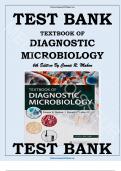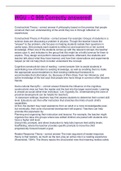Ultimatestudyguide2021@gmail.com
TEST BANK
M
TEXTBOOK OF
DIAGNOSTIC
ED
MICROBIOLOGY
C
6th Edition By Connie R. Mahon
O
N
N
O
IS
SE
U
R
TEST BANK Ultimatestudyguide2021@gmail.com
, Chapter 01: Bacterial Cell Structure, Physiology, Metabolism, and Genetics
Mahon: Textbook of Diagnostic Microbiology, 6th Edition Test Bank
MULTIPLE CHOICE
1. To survive, microbial inhabitants have learned to adapt by varying all of the following, except
a. growth rate.
b. growth in all atmospheric conditions.
c. growth at particular temperatures.
M
d. bacterial shape.
ANS: D
ED
The chapter begins by discussing the way microbial inhabitants have had to evolve to survive
in many different niches and habitats. It discusses slow growers, rapid growers, and
replication with scarce or abundant nutrients, under different atmospheric conditions,
temperature requirements, and cell structure. Bacterial shape as a form of evolution is not
discussed.
C
OBJ: Level 2: Interpretation
2. Who was considered the father of protozoology and bacteriology?
O
a. Anton van Leeuwenhoek
b. Louis Pasteur
c. Carl Landsteiner
N
d. Michael Douglas
ANS: A
The book discusses Anton van Leeuwenhoek as the inventor of the microscope and the first
N
person to see the “beasties.” So they dubbed him the father of protozoology and bacteriology.
The other three individuals were not discussed.
O
OBJ: Level 1: Recall
3. Prokaryotic cells have which of the following structures in their cytoplasm?
IS
a. Golgi apparatus
b. Ribosomes
c. Mitochondria
d. Endoplasmic reticulum
SE
ANS: B
All the structures listed are found in eukaryotic cells, but ribosomes are the only ones that
apply to prokaryotic cells.
OBJ: Level 1: Recall
U
4. This form of DNA is commonly found in eukaryotic cells.
a. Linear
R
b. Circular
c. Plasmid
d. Colloid
Ultimatestudyguide2021@gmail.com
TestBanks/ Solution Manuals and Exam
, ANS: A
Circular and plasmid DNA are usually found only in bacteria, not eukaryotic cells. Colloid is
a property of protein molecules and is not associated with nucleotides.
OBJ: Level 1: Recall
5. The nuclear membrane in prokaryotes is
a. missing.
M
b. impenetrable.
c. a classic membrane.
d. a lipid bilayer membrane.
ED
ANS: A
Prokaryotic cells do not have any membrane-bound structures in the cytoplasm including a
structured nucleus.
OBJ: Level 1: Recall
C
6. A microorganism that is a unicellular organism and lacks a nuclear membrane and true
nucleus belongs to which classification?
a. Fungi
O
b. Bacteria
c. Algae
d. Parasite
N
ANS: B
Fungi, algae, and parasites are unicellular eukaryotic organisms that contain a true nucleus.
Bacteria are prokaryotic and do not contain a true nucleus or nuclear membrane.
N
OBJ: Level 1: Recall
O
7. In the laboratory, the clinical microbiologist is responsible for all the following, except
a. isolating microorganisms.
b. selecting treatment for patients.
c. identifying microorganisms.
IS
d. analyzing bacteria that cause disease.
ANS: B
Clinical microbiologists do not select the treatment for patients. They provide the doctor with
SE
the name of the organism and the antibiotics that can kill the bacteria, but not in the final
selection of treatment protocols.
OBJ: Level 2: Recall
8. What enables the microbiologist to select the correct media for primary culture and optimize
U
the chance of isolating a pathogenic organism?
a. Determining staining characteristics
b. Understanding the cell structure and biochemical pathways of an organism
R
c. Understanding the growth requirements of potential pathogens at specific body site
d. Knowing the differences in cell walls of particular bacteria
ANS: C
, By understanding growth requirements, a microbiologist can maximize the chance of the
organism being isolated from a culture. The other three choices are used to identify a
bacterium once it has grown on media.
OBJ: Level 2: Interpretation
9. A clinical laboratory scientist is working on the bench, reading plates, and notices that a
culture has both a unicellular form and a filamentous form. What type of organism exhibits
M
these forms?
a. Virus
b. Fungi
c. Bacteria
ED
d. Parasite
ANS: B
Viruses typically only have one form and would not grow on plate media. Bacteria have two
forms: a vegetative cell and spore form. Parasites may have trophozoite, cysts, egg, etc. Fungi
are the organism classification that may have both unicellular yeast forms and filamentous
C
hyphal forms in the same culture plate.
OBJ: Level 2: Interpretation
O
10. All of the following statements are true about viruses, except:
a. Viruses consist of DNA or RNA but not both.
N
b. Viruses are acellular but are surrounded by a protein coat.
c. Viruses can infect bacteria, plants, and animals.
d. Viruses do not need host cells to survive and grow.
N
ANS: D
Viruses need to have a host cell because they do not have the ability to reproduce or nourish
themselves without the host’s cellular mechanisms.
O
OBJ: Level 2: Interpretation
IS
11. Diagnostic microbiologists apply placement and naming of bacterial organisms into all the
following categories, except
a. order.
b. family.
SE
c. genus.
d. species.
ANS: A
Clinical microbiologists use the family, genus, and species taxonomic categories to identify
species that are important for diagnostic diseases.
U
OBJ: Level 1: Recall
R
12. Bacterial species that exhibit phenotypic differences are considered
a. biovarieties.
b. serovarieties.
c. phagevarieties.
d. subspecies.
Ultimatestudyguide2021@gmail.com
TestBanks/ Solution Manuals and Exam





